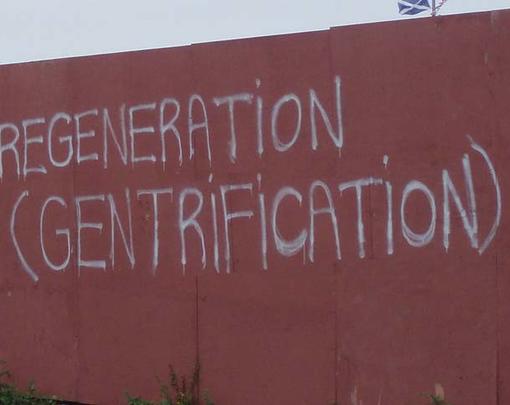A broad array of technological advances are set to converge on our political economy over the next few decades: advanced robotics, augmented reality, machine learning, machine vision, the internet of things, and beyond. A range of observers, from economists to labor organizers to businesspersons, are concerned that the resulting workforce disruption could cause serious economic and even political instability given the unprecedented scope and pace of these convergences.
The policy response most commonly associated with projections and expectations of technological unemployment and underemployment is the universal basic income (UBI), a measure intended to reallocate the wealth generated by this high-tech, highly productive, but highly unevenly distributed economy. While wealth redistribution is undoubtedly vitally important in this new technological era, more important will be ensuring that some conception of common ownership becomes enshrined either in law or in cultural values—or preferably in both.
Equity for workers is often front and center in any examination of the effects of increased automation. However, the implications for workers are directly tied to ecological health as well. Alongside the “labor saving” aspect of technological progress lies too the prospect of increased production and concomitant increased throughput in the form of limited natural resources. Advanced algorithms sorting through data will no doubt result in increased efficiency. However, under the current framework of competition, consumption, and rising living standards globally, whatever benefits that might accrue in increased savings for purchasers due to downward pressure on prices implies costly throughputs derived from the limited, constantly shrinking, natural world.
In The Economic Possibilities of Our Grandchildren (1930), John Maynard Keynes wrote that in a hundred years humanity would be compelled to face its “real,” [its] permanent problem…”: how to occupy abundant leisure time absent the threat of material deprivation. (This, of course, was juxtaposed to what he viewed as the more time-bound, eminently solvable “economic problem,” i.e. “the struggle for subsistence.”) Today we’re not far from a century on, by which time Keynes was confident we would have solved the latter problem. Keynes, however, named avarice and compound interest as the “gods” that will liberate society from its economic problem, gods that now appear ill-equipped for the task. We might look instead not to gods but to distributed forms of ownership—like worker-owned enterprises, consumer cooperatives, and public ownership—that go beyond the crossed-fingers of a profit-driven progress; these forms of ownership also go beyond the equalizing demand of the UBI model toward democratizing the future itself.
Automation Equity: Beyond Basic Income
The consequences and implications of automation are increasingly embedded in conversations about UBI. Speaking to WIRED magazine about the ramifications of artificial intelligence, US President Barack Obama even seemed open to the idea. A UBI may indeed deliver on its promise to eliminate extreme poverty and reshape our relationship to work, but securing a future defined by equality and freedom requires distributed, democratic ownership structures. These structures eschew the more vertical hierarchies of traditional firms and offer workers a vote not just in the workplace, but in the broader economy as a co-owner.
As transformative as a UBI is thought to be, most of the discourse is focused around subsistence levels of redistribution—food and shelter, for example, and or the question of whether or not UBI would replace or supplement traditional anti-poverty programs. (Notable exceptions include Yanis Varoufakis’ conception of a universal basic dividend, and Gar Alperovitz’s “technological inheritance.”) In this sense, the program would no doubt provide a welcome level of economic security by “raising the floor,” but it would stop short of ensuring widespread economic prosperity. Moreover, UBI would make all citizens co-beneficiaries, but not the co-decision makers in society’s broader economic activity. It may in fact subsidize the United States’ flagging “economic democracy” score. Whatever welcome paradigm shifts UBI may offer, proponents should be aware of its limitations and consider how to overcome them.
The challenge posed by automation is not just how to provide new jobs as others are taken over by machines, but also how to democratize an economy in which power is increasingly concentrated into the hands of a small cadre of private owners. This is not a new phenomenon, considering the effects of global trade on western labor markets, but one that will be exacerbated by increasingly automated services, production processes, and so on. The lingering question becomes: Does UBI sufficiently address this dilemma? Though there are of course different conceptions of how funds for a nation-wide UBI are acquired, assuming that the money is being redistributed, this is not, by itself, a formula for unlocking social mobility and preventing the formation of an underclass unable to meaningfully participate in the economy and with little power within it.
Writing to downplay the effects of automation on employment, columnists for the Washington Post and Forbes have both noted that it is the service sector that will likely to expand to accommodate the need for gainful employment for the technologically dispossessed. They suggest that as capital accumulates for those who own automated systems, this wealth will trickle down through additional spending on services. Unironically, one author points to the growth of positions for yoga instructors as manufacturing jobs dwindle, another imagines that in an age of automation more people would be employed as the on-demand artisans and entertainers of robot moguls. Warning of robot-powered “economic polarization,” MIT economist David Autor agrees with these premises, but is more forthright about their grim implications:
“Employment polarization creates real challenges. It knocks out rungs on the economic ladder, potentially shrinks the size of the middle class, and threatens to make our Western societies less mobile. On the one hand: a set of highly-paid, highly-educated workers doing rewarding, interesting work and also a growing set of low-education, low-paid workers whose primary job it is to see to the health and comfort of the affluent. That’s not most people’s vision of societal progress and it’s not mine either.”
There’s an implicit, but undefined premise at work here. As machines advance to replace the physical and, increasingly, mental labor of manufacturing workers, actuaries, long haul truckers, customer service representatives, etc., displaced workers will still be required—as a matter of survival—to sell their labor. Keynes’ was forthright enough in admitting that the engine for solving his economic problem was “avarice,” but alongside that vice, such a system is also driven by the constant threat of material deprivation. Does UBI sufficiently address this dilemma? At best, a UBI would similarly leave the lower class at the mercy of the affluent, if only for acquiring the supposed “luxuries” that a UBI would leave out of reach. For all the good such a program would do, the benefits are unrelated to the polarizing effects of automation. A UBI dampens the worst conceptions of increased inequality by offering the working class subsistence in place of an escape from economic and social obsolescence.
Greening the Robot Revolution With Democracy
The primary limitation of the UBI model that should concern those preoccupied with projections of technological unemployment is the power disparity between those who own the highly productive capital of the automation age and those who do not. The concentration of ownership carries with it the monopolization of economic and political control. Without unmooring technological disruption from the singular motive of profit, it becomes impossible to effectively prioritize crucial issues like privacy, social justice, or climate change—the latter we will explore below. Personal information is thus a commodity; biases are digitally reproduced; ecological stewardship is forsaken for quarterly returns and advantage over competitors. However, conversely, as ownership structures become more distributed they become democratized not just with respect to the distribution of profits but more crucially in decisionmaking processes. While democratic institutions are not immune to poor, destructive, or oppressive decisions, they are not mandated to make them by supposed fiduciary responsibilities to economic and social elites.
The issue of environmental degradation is one rarely discussed in discourses around automated production. There are a number of utopian conceptions of abundance associated with automation, including that tremendous amount of goods and services will be produced and sold cheaply. But these imaginings rarely consider the ecological throughput required to realize them. More broadly, it is all too common for mainstream economics to fail to account for such “externalities” as the environment, but this ideological failing is directly linked to miscalculations of automation’s effect on workers.
Often cited in response to automation woes, as Branko Milanovic does, is the “lump of labor” fallacy. The notion that all work can be automated (and thus disrupt society with joblessness) is absurd, so we are told, because the demand for labor is related to human desires, which are said to be insatiable. But further still, these claims are premised on infinite abundance in the natural world, which is sadly not the case. Milanovic goes on to address this:
Our experience teaches us that these [ecological] limits are much wider than we generally think at any point in time because our knowledge of what earth contains is itself limited by our level of technology. The better our technology, the more reserves of everything we discover. Yet accepting that X is an exhaustible energy source or a raw material and that at the current rate of utilization it will run out in Y years is only a part of the story. It neglects the fact that with the rising scarcity and price of X, there will be greater incentive to create substitutes (as inventions of sugar beet, synthetic rubber or fracking show) or to use a different combination of inputs to produce the final goods that now use X.
Resource substitution may indeed be a hallmark of human ingenuity, but all the same it is removed from real, ongoing environmental harm. It’s true that fossil fuels will grow more expensive as reserves dwindle over the coming decades, but can the environment sustain continuous carbon emissions while waiting for profit-logic to adjust? Will the earth’s dwindling biodiversity survive long enough to see more favorable market conditions? Exxon Mobil, whose outgoing CEO has been nominated to head the US Department of State, has more than mere incentive to see arctic oil reserves exploited—the company has a duty to its shareholders to do everything in it’s power to realize the exploitation of every drop of crude oil, every ounce of tar sands.
Even when it comes to seemingly abundant resources, continued and accelerated exploitation has dramatic consequences on the natural world. Milanovic reminds his readers of a centuries-dead economist who laughably hoarded paper over unrealized fears of a global lumber scarcity, but he would surely admit that the current rate of deforestation is grossly harmful to global ecosystems. Furthermore, while the rare earth metals that are critical to our modern digital lives are thought to be plentiful, as they are mostly concentrated in China there are plans to begin tearing them out of the ocean floor in the name of competition. With workers as owners, with local communities as constituents, concerns about the environment are not avoidable externalities that profiteers are free to ignore; They’re an inescapable part of the equation.
We are told that technological advancement will only make things more efficient and it follows that this will lead to sustainability, but we see quite clearly today that even the data driving this efficiency is a proprietary commodity to be bought and sold by private companies, run through algorithms designed by private companies for no nobler end than profits for private companies. Within the context of such a system, decisions are made by private entities while the inevitable consequences of environmental degradation are borne by the public. Again, we are led back to the need to prioritize economic democracy over private interests.
It is, however, worth repeating that distributed forms of ownership are not inherently able to choose less poorly than private companies. A publicly-owned utility in one area may prioritize lower costs for constituents, while another may prioritize achieving 100% renewable energy. A worker-owned cooperative may all the same choose higher profits over a lower carbon footprint, but the point is there is a choice being made in such scenarios (and some semblance of democratic participation in that choice), with options beyond avarice. The question becomes whether societies want decisions about economic throughput—ranging from mountaintop-removal mining, soil degrading agricultural production, carbon emissions, and far beyond—to be made democratically in the context of a diverse set of distributed forms of ownership, or whether they should be made under the myopic priorities of shareholder obligations.
But beware!
“But beware! The time for all this is not yet. For at least another hundred years we must pretend to ourselves and to every one that fair is foul and foul is fair; for foul is useful and fair is not. Avarice and usury and precaution must be our gods for a little longer still. For only they can lead us out of the tunnel of economic necessity into daylight.”—John Maynard Keynes, The Economic Possibilities of Our Grandchildren, 1930.
For Keynes, the theory of change in transitioning from enduring a wilderness of scarce resources to enjoying a society of abundance was defined by greed and profit-motives. However, these motivations appear today more likely to lead us to ruin, through both environmental and socio-economic destruction. Automation only has the capacity to solve his economic problem if we agree that it should solve the problem for everyone rather than just for the current owners of capital. If fears of automation are centered around the idea that owners may soon not need the workers, then we must go beyond UBI’s promise of redistributed wealth and build institutions whereby the workers and the owners become one and the same.
Democratizing ownership mean democratizing design, labor, leisure, and democratizing the distribution of wealth. UBI is a worthy policy for a number of reasons, but its growing association with the challenges of automation is not justified. It represents economic security while falling short of the economic democracy that follows from distributed ownership structures. Shortcomings remain, to be sure, regarding automation and the environment—relating to overconsumption, competition, etc.—but these challenges will need to be met with collective decisionmaking. The solution to Keynes’ economic problem will not be found by the gods of “avarice and usury and precaution,” but rather with democracy and equity. This is the central challenge of the automation age and primary consideration in ensuring that all of humanity earn the right to confront Keynes’ “permanent problem” of self-determination in a world free from want.




